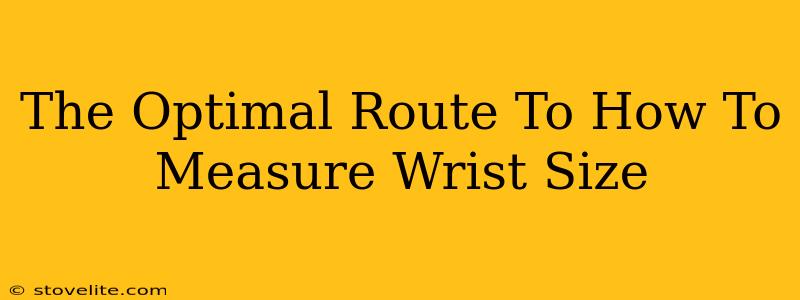Finding the perfect fit for a watch, bracelet, or even a sleeve can hinge on knowing your wrist size. But how do you measure it accurately? It's simpler than you think! This guide breaks down the optimal methods to ensure you get a precise measurement every time.
Why Knowing Your Wrist Size Matters
Before diving into the how, let's understand the why. Accurate wrist measurement is crucial for:
- Watch and Bracelet Shopping: Avoid the frustration of ill-fitting accessories. A properly sized watch or bracelet is comfortable and looks fantastic.
- Clothing Purchases: Sleeve length and cuff comfort often depend on wrist size, especially for tailored garments.
- Medical Assessments: In certain medical contexts, wrist circumference can be a relevant measurement.
The Tools You'll Need
You won't need any specialized equipment. For accurate wrist size measurement, all you need is:
- A Flexible Tape Measure: A soft, fabric tape measure is ideal. Avoid stiff plastic tapes that might pinch your skin and provide an inaccurate reading.
- A Pen and Paper (Optional): Jot down your measurement to avoid forgetting it.
How To Measure Your Wrist Size: Step-by-Step Guide
Here's the most accurate method for measuring your wrist size:
-
Find Your Wrist Bone: Locate the prominent bone on your wrist, usually near the base of your hand.
-
Position the Tape Measure: Wrap the tape measure around your wrist, directly above this wrist bone. Make sure the tape is snug but not overly tight – you want a comfortable fit, not constriction.
-
Read the Measurement: Look at where the tape measure overlaps to find your wrist circumference. Record this number. Most tape measures will give the measurement in either inches or centimeters.
-
Take Multiple Measurements: For extra accuracy, take two or three measurements and average them. This helps account for any slight variations.
Common Mistakes To Avoid
-
Too Tight or Too Loose: Avoid overly tight measurements that constrict your wrist, or overly loose measurements that don't reflect your actual size. Aim for a snug but comfortable fit.
-
Incorrect Placement: Ensure you're measuring at the base of your wrist, above the wrist bone, not higher up on your forearm.
-
Ignoring Units: Remember to note whether your measurement is in inches or centimeters. This is crucial when purchasing items online.
Understanding Your Measurement: Inches vs. Centimeters
Measurements are usually provided in either inches or centimeters. If you’re unsure how to convert, use an online converter. Most online retailers will provide sizing charts showing both inches and centimeters.
Beyond the Basics: Addressing Specific Scenarios
Measuring a Child's Wrist: Measuring a child's wrist requires extra gentleness and patience. Ensure the tape measure is snug but not causing discomfort.
Dealing with Swelling: If you have swelling in your wrist, it's best to measure at a time when the swelling is minimal or consult a healthcare professional for advice.
Finding Your Correct Watch Size: Many watch brands offer detailed sizing guides on their websites. Refer to these charts alongside your wrist measurement.
Conclusion: Mastering Wrist Size Measurement
Measuring your wrist size accurately is a simple yet essential skill for ensuring the perfect fit for various accessories and garments. By following these steps and avoiding common mistakes, you'll be confident in your measurement every time! Now go forth and conquer your shopping endeavors with perfectly sized wristwear!

